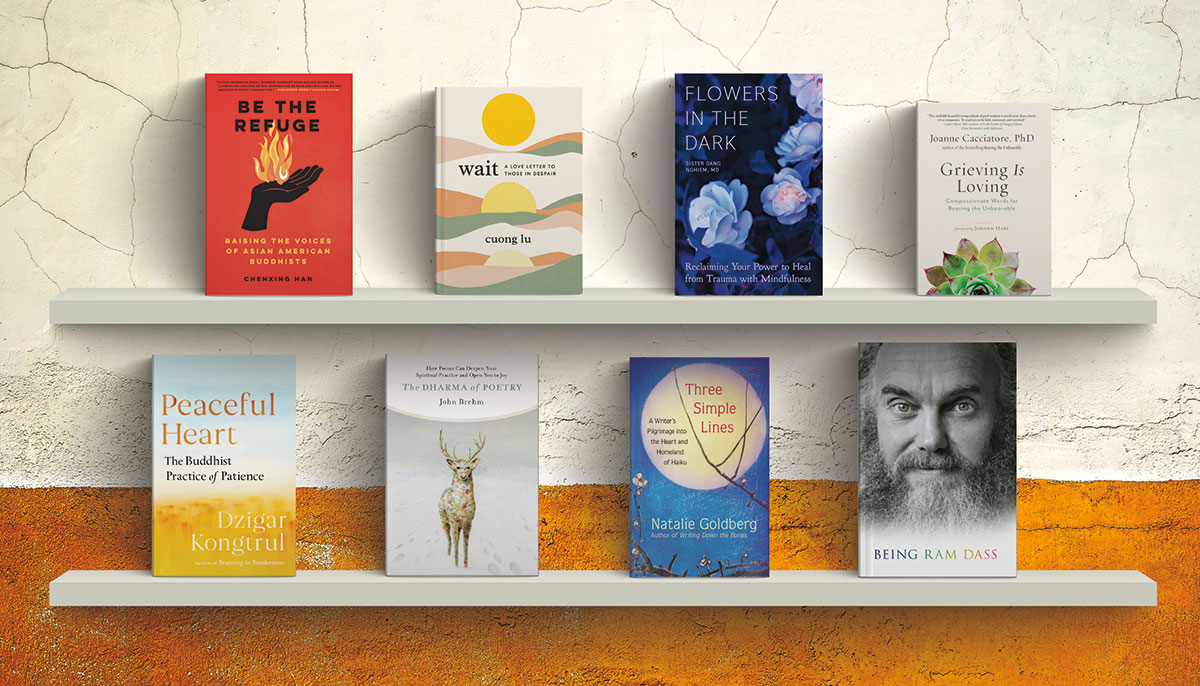“Where are all the young adult Asian American Buddhists, and what can we learn from them?” asks Chenxing Han in Be the Refuge: Raising the Voices of Asian American Buddhists (North Atlantic Books). In search of an answer, Han interviewed eighty-nine people from this demographic, exploring their cultural and religious backgrounds; their beliefs, practices, and communities; and their thoughts about how they have been represented. “In sharing their stories,” writes Han, “they advocate for solidarity between Asian American Buddhists of different ethnicities—and indeed among Buddhists of all cultural backgrounds.”
Each section of Han’s groundbreaking volume traces the history of important Asian American Buddhists’ contributions in the West—from the initial trailblazers, to the bridge-builders, to the integrators, to the refuge-makers. In doing so, it firmly challenges the established Western narrative of who these Buddhists are and what they believe. Han writes, “The Asian American Buddhists featured in this book refuse to be reduced to Oriental monks, superstitious immigrants, and ‘banana Buddhists.’ They champion nuanced representations over stale stereotypes. They cultivate sanghas that are inclusive and accessible. They embody the boundless possibilities for interconnection that glow at the heart of American Buddhism in all its dynamism and diversity.”
Also this season, three new books on loss and trauma extend a balm for difficult times, each author speaking with the force of wisdom that comes from lived experience. Cuong Lu, a scholar, writer, and Buddhist teacher in the Plum Village tradition, recalls fleeing Vietnam with his family in 1975 and witnessing the shooting death of a man. This early trauma propelled him to seek out the profound knowledge and practices that have the power to end violence—against each other and within ourselves. In Wait: A Love Letter to Those in Despair (Shambhala), Lu writes, “When you stay fully present with your feelings, your sensations, and the world around you, even when it seems dark and cold, joy will arise. Joy and suffering are two sides of the same coin.”
Mindfulness teacher and physician Sister Dang Nghiem, a nun in Thich Nhat Hahn’s Order of Interbeing, is the author of Flowers in the Dark: Reclaiming Your Power to Heal from Trauma with Mindfulness (Parallax Press). In this lucid and accessible guide, Nghiem shares the practices that have helped her in her own journey to heal from the devastating effects of war, childhood abuse, and the death of her beloved partner. “The ‘mud’ and mess of our most painful experiences can become the fertile ground for the blossoming of our understanding and self-compassion,” writes Nghiem. “This is a hard truth to accept if we are resolved to seeing a good life as consisting only of positive events. It is true that the cool waters of happiness are sweet and precious, but it is suffering that carves our cup.” Drawing from Buddhist psychology and somatic practices, each chapter in Flowers in the Dark delivers step-by-step instruction for working with trauma.
“Right in the center of our very wise hearts is the realization that we feel extraordinary grief because of extraordinary love. If we can become still enough, if we can listen to our hearts, it knows that grief is not the enemy,” writes Joanne Cacciatore in her new book, Grieving Is Loving: Compassionate Words for Bearing the Unbearable (Wisdom). Composed in a style reminiscent of the quote-a-day format, this volume contains distilled excerpts from Cacciatore’s award-winning book Bearing the Unbearable: Love, Loss, and the Heartbreaking Path of Grief, alongside an abundance of new material. Each selection is both an offering and a meditation for those who have experienced devastating loss. “When you feel the pull of your grief,” says Cacciatore, “take this book to a quiet corner, outside in the sun or in your room or where you feel respite, and read from wherever in the book you are called to read.”
How do we cultivate an open heart? In his new book, Peaceful Heart: The Buddhist Practice of Patience (Shambhala), Tibetan Buddhist teacher Dzigar Kongtrul illuminates the concept of tsewa, the heart that is tender. “Beneath our ambitions and activities, what we all seek comes down to something very simple—a sense of well-being, full of joy, peace, satisfaction, meaning, and spark,” he writes. “We want these feelings to be with us not just for some scattered moments but all the time, without any interruptions.”
The selections in Peaceful Heart are based on Kongtrul Rinpoche’s talks over the past twenty-five years focusing specifically on verses from the Patience chapter of Shantideva’s Way of the Bodhisattva. “It’s important to emphasize that patience is a practice—a practice of learning to experience feelings that are hard to tolerate without reacting in ways that cause harm to oneself or others.”
Two new books on Buddhism and poetry remind us that dharma and practice come in many forms. In The Dharma of Poetry: How Poems Can Deepen Your Spiritual Practice and Open You to Joy (Wisdom Publications), John Brehm offers guidance for working with poetry as a contemplative practice. Broken into two sections, this book first explores in depth the work of several noteworthy poets; the second section imparts advice for facilitating dharma-focused poetry discussions.
Rather than employing heady literary analysis, Brehm directs the reader to encounter each poem in terms of the insights it reveals. “When we enter poems fully,” writes Brehm, “when we experience them rather than think about what they mean, they can release us from our sense of separateness and from the kind of obsessive self-concern that leads inevitably to suffering.” Interspersed throughout the book are meditations and writing activities. This volume would no doubt serve as a handy companion to Brehm’s previous book, a poetry anthology entitled The Poetry of Impermanence, Mindfulness, and Joy.
In her latest book, writing guru and Zen practitioner Natalie Goldberg shares her own journey into poetry as practice. Three Simple Lines: A Writer’s Pilgrimage into the Heart and Homeland of Haiku (New World Library) is a thoughtfully crafted memoir spanning her multiple pilgrimages to Japan, as well as glimpses of her home and life in New Mexico. At times employing the Japanese writing form haibun (a mix of prose and haiku) Goldberg bears witness to place, creativity, impermanence, and the eternal moment. “Haiku is a refuge when the world seems chaotic,” Goldberg says, “when you are lost, frightened, tangled, and nothing is clear.”
Being Ram Dass (Sounds True), an autobiography by the late spiritual icon (with Rameshwar Das), provides a fascinating deep dive into the spiritual odyssey of one of the West’s most influential spiritual teachers. The author of Be Here Now writes, “My life has been a succession of openings, accompanied by profound changes in point of view, how I identify who I am, how I see myself.” Revealing the greater cultural and spiritual evolution in which he was ensconced, Dass unpacks four decades of his past—from his early years researching psychedelics with Timothy Leary, to meeting his guru Neem Karoli Baba in India and becoming a yogi, to establishing the nonprofit Living/Dying Project, to confronting his own impermanence. Dass writes, “This is a story of awakening from feeling separate and alienated toward living in oneness and love.”

